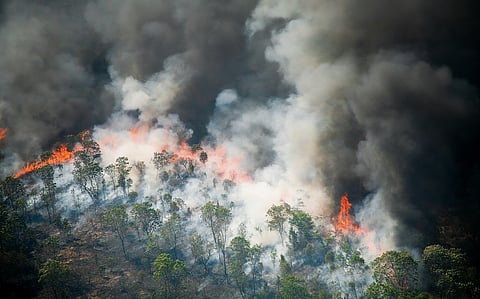

Driven largely by massive fires, the tropics lost 6.7 million hectares of primary rainforest in 2024. This record-breaking tropical forest loss seen in 2024 is more than any other year in at least the last two decades.
The new data from the University of Maryland’s GLAD lab and available on World Resources Institute (WRI) Global Forest Watch platform revealed that tropical primary forest disappeared at a rate of 18 football fields per minute in 2024. This was nearly double that of 2023. The loss of these forests in 2024 is estimated to have caused 3.1 gigatonnes of greenhouse gas emissions.
Latin America was the hardest hit, so much so that the reduction in primary forest loss seen in Brazil and Colombia in 2023 was reversed.
Primary forest loss unrelated to fires also increased by 14 per cent between 2023 and 2024. This was mostly driven by conversion of forests to agriculture.
Previously, forest clearing for permanent agriculture was the largest driver of tropical primary forest loss, while in 2024 wildfires became the largest driver, responsible for almost half of the loss.
Primary forest loss increased exponentially in the Brazilian Amazon due to fires. Brazil held the dubious distinction for being the country which experienced the largest tropical primary forest loss in 2024. In 2024, Brazil experienced the worst drought in seven decades. This, combined with high temperatures, caused fires to spread. After fire, primary forest loss in Brazil was mostly caused by clearing forests for soy and cattle farming.
Brazil was followed by Bolivia, the Democratic Republic of Congo, Indonesia, Peru, Laos, Colombia, Cameroon, Nicaragua and Mexico.
Tree cover loss globally also reached a record high, with boreal regions like Canada and Russia experiencing extreme fires.
A statement from Global Forest Watch said though the tree cover loss data from the University of Maryland has global coverage, Forest Watch especially focuses on loss in the tropics because that is where 94 per cent of deforestation and human-caused long term removal of forest occurs. The primary forests in the tropics are areas of mature rainforest that are important for biodiversity, carbon storage and regulating regional and local climate.
There were some bright spots too in 2024 — Indonesia and Malaysia experienced less primary forest loss than in 2023. The rates of loss were well below what they were a decade ago.
The dual effects of climate change and conversion of forests to other land uses like agriculture make it difficult for forests to recover and they become more vulnerable to future fires.
The World Meteorological Organization (WMO) said 2024 was the warmest year on record — at about 1.55°C above pre-industrial level. In addition, the hot and dry conditions mainly caused by climate change and El Niño contributed to larger and more widespread fires.